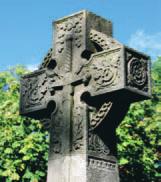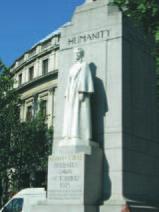Basic HTML Version



12
BCD Special Report on
Historic Churches
18th annual edition
two world wars inevitably generated a special
culture of memorials because, for almost
the first time, there was a realisation that all
ranks of fighting men and women who had
sacrificed their lives should be commemorated.
The deaths of some 700,000 British soldiers
in World War I (WWI) led to the building of
the local memorials that are such a familiar
sight in our towns and villages. The scale of
this mass commemoration is clear from the
Imperial War Museum’s ongoing National
Inventory of War Memorials which, it is
estimated, will run to over 100,000 memorials.
It is not always realised that although
at least two thirds of the memorials on the
inventory relate to WWI they were not
nationally funded or organised in any way by the
government. While the Imperial War Graves
Commission was set up in 1917 at the initiative
of Fabian Ware (it became the Commonwealth
War Graves Commission in 1960), it was
established only to create cemeteries abroad for
those killed while serving in the British Empire
and Commonwealth forces. In Britain it was
down to local committees to raise funds, find
suitable sites and select the designs of every
local war memorial. An advisory committee
was set up in 1919 to offer advice on memorial
designs provided by the Royal Sculpture
Association and an exhibition of designs was
organised by the Royal Academy, accompanied
by a pamphlet suggesting suitable inscriptions.
Extraordinary local effort went into
ensuring the lists of names were accurate. There
were no national government instructions so
local war memorial committees had immense
responsibilities. It was the independent nature
of every local committee that led to the
enormous variety of war memorials, not just
in terms of design but sometimes in terms
of the medium itself. Should memorials have
a useful purpose? Should they be hospitals,
gardens or community halls, for example? How
traditional should the design be and how could
they be designed to reflect the universality of
the sacrifice? Different communities answered
these questions in different ways. Memorials
included chapels, bell or clock towers, hospital
wings or wards, gardens and sports fields, village
halls, reading rooms, fountains, murals and
mosaics. In churches alone, memorials take
the form of lych gates, stained glass windows,
plaques, lecterns, organs and screens.
The work of the local memorial committees
was a remarkable process that must have
been a united effort inspired by the common
loss. Nothing is more difficult than achieving
agreement on aesthetic matters and the results
are inevitably mixed in quality. They are,
nevertheless, united in sentiment and the wish
to record the community’s losses and honour
the various wartime roles its members had
played. It is intriguing to examine the breadth
of design solutions across the country.
There are the memorials to individual
heroes or commanders ranging from field
marshals to political leaders. These sometimes
followed tradition by showing leaders mounted
on horseback or looking belligerent, like Ivor
Roberts-Jones’ iconic statue of Churchill in
Parliament Square. Memorials to individuals
were sometimes designed to emphasise bravery
or devotion to duty, like the statues to Edith
Cavell which seem to encompass the efforts
of all the women who worked in the nursing
field. There are memorials, often in churches,
to individual family members lost at a very
young age. The work of the poet Rupert Brooke
or the ‘Age shall not weary them, nor the years
condemn’ sentiment of Laurence Binyon’s
famous poem seems to have inspired these
figurative memorials – eternal youth somehow
offering a comfort for youth eternally lost.
Equally numerous are the monuments
that record the efforts and sacrifices of groups
of service personnel – individual regiments or
squadrons or ships’ companies. These are often
both inspiring and heartbreaking, recording as
they do the selfless efforts of groups of young
servicemen, sometimes shown with their ages
and the parishes to which they belonged.
Towns, cities and villages recorded their
dead on sites that range from church walls and
graveyards to street corners and traffic islands.
In major cites like Rochdale, Manchester
and Derby, the WWI memorials incorporate
effigies of the dead soldier, usually draped in
his greatcoat and elevated on a plinth. They
served as catalysts for the town’s bereaved
families, who could identify their own losses
through the universal image of the dead warrior.
The emotional power of the WWI memorials
was often such that the names of those lost in
WWII were added to them: a new generation
of personal sacrifices inscribed beside the old.
Businesses whose staff had died during
the two world wars often created special
memorials in their shops or offices. Schools
and colleges, too, took care to remember their
dead – the moving cloister by Sir Herbert
Baker at Winchester College comes to mind,
as does the Gate of Honour at Mill Hill
School. Both memorials continue to remind
new generations of pupils of the sacrifices
of their forebears. Elsewhere, groups of
tradesmen are commemorated or civilian
workers in the munitions factories or those
in the home front emergency services.
The changing ‘language’ of war memorials,
the variety of forms, styles and subjects that
they have taken historically, reflects intense
national debates about what constitutes an
appropriate memorial. The question remains
unresolved today: selecting a design for the
latest memorial for those who have been
killed in conflicts since the end of WWII,
at the National Memorial Arboretum at
Alrewas in Staffordshire, was a source of much
debate. As conflicts become more divisive
and less morally clear-cut, deciding how to
commemorate the nation’s war dead may well
become an even more controversial issue.
The role of War Memorials Trust
The more memorials there are, the more there
is to maintain to ensure the dead continue to
be honoured. War Memorials Trust (WMT)
was set up in 1997 in response to a growing
need to establish clear responsibility for the
maintenance and protection of the nation’s
war memorials. Their creation by local
committee holds the seeds of doubt about
who is responsible for their maintenance.
Uncertainty over ownership can lead to neglect
Detail of the limestone wheel-cross war memorial
at St Lawrence’s Church, Eyam, Derbyshire
(Photo: iStockphoto.com/RF Stock)
Memorial to the nurse and humanitarian Edith
Cavell in St Martin’s Place, London: Cavell was
executed by a German firing squad in 1915 for helping
Allied prisoners to escape from occupied Belgium
(Photo: War Memorials Trust)
The Burma Star window at St John the Baptist Church,
Cardiff commemorates those killed in Burma during
WWII (Photo: St John the Baptist Church, Cardiff)

